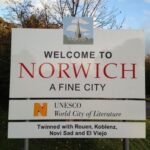Norwich
 The Fine City Norwich, my home and business base, is a city filled with historic streets, heritage sites, independent businesses and an ancient and is lively and historically multi-cultured.
The Fine City Norwich, my home and business base, is a city filled with historic streets, heritage sites, independent businesses and an ancient and is lively and historically multi-cultured.
The History
Everyone has heard of Boudicca, the Queen of the Iceni, her fight against the Romans in 60AD that covered the area from South Norfolk (Venta Icenorum). Unfortunately, Boudicca’s valiant fight did not succeed and the Romans took control of the area including Norwich. Today you can walk the Boudicca Way footpath from Norwich to Diss. Caistor St Edmund, just outside Norwich has a heritage site where you can see the outline of a Roman Town.
Then the Anglo Saxons slowly invaded and scattering settlements gaining control and building a fortress, Norwic (Norwich). The farm land surrounding the strong hold was ideal for growing crops and the rivers had a connection to the sea. Norwich became a manufacture and trading centre for pottery and steel.
Up pop the Danes and invaded in 866AD, they seemed to rub along with the Anglo Saxons until Edward the Elder took back control 50 plus years later. Tombland in Norwich has remanence of the Vikings, an association with the market-place tom (Danish for market) name and not a place of mass burial as assumed today.
Norwich was trending Norman by their invasion in 1066 and by then Norwich was one of the biggest towns in England and a successful manufacturing and trading hub. The Normans built a castle, a cathedral and a defensive wall around the town.
Between 1066 and 1485 we enter the medieval period and in 1194, due to Norwich’s strong textile manufacturing market and agricultural production Richard the Lionheart gave Norwich a Royal Charter to become a city
Norwich prospered through the medieval period due to it’s thriving textile trade and became financially wealthy. It showed off it’s affluence by building lots of churches, many standing today and change of use from worship to cafes, art centres, workplace hub and many other uses.
However, good times changed to bad times and the rat induced plague hit the south coast of England in autumn of 1348, spreading throughout the country via trade routes. The plague hit the city of Norwich a year later and it is estimated (all though no records were kept) 25k people died of bubonic plague leaving just 6k surviving. The dead where buried in communal pits around the cathedral and other buried in St Georges, Tombland (you can see why the names is associated with death rather than the Danish market name).
From 1650 to 1750 (1800s) Norwich was documented and England’s 2nd city, London being the 1st. Printing and leather became a developing industry in Norwich. A train line completed in 1845 between Norwich and London, gave Norwich a trending name as a major manufacturer for the shoes and boots.
Other famous 18th century associations with Norwich are Colman’s Mustard, the building of the Roman Catholic Cathedral and the Norwich School for art, established by John Crome.
From the 20th century and beyond Norwich has developed including Norwich City Football Club celebrity chef, Delia Smith majority shareholder and supported by actors Hugh Jackman and Stephen Fry. The University of East Anglia, a revamped market place with 189 stalls of individual sole trader entrepreneurs. Eclectic shopping experience with two shopping centres. Several museums showcasing Norwich’s past. An abundance of restaurants, coffee shops and cocktail bars.
Norwich the gateway to The Broads National Park, 12th century man-made waterway created by peat digging and now a popular tourism attraction for wonderful days sailing or cruising on the waterways of Norfolk and Suffolk.
If you are staying in Norwich and need pampering, catering or mobile activities contact us. Or link to Kayak’s Norwich Holiday Guide for attractions and places to visit.